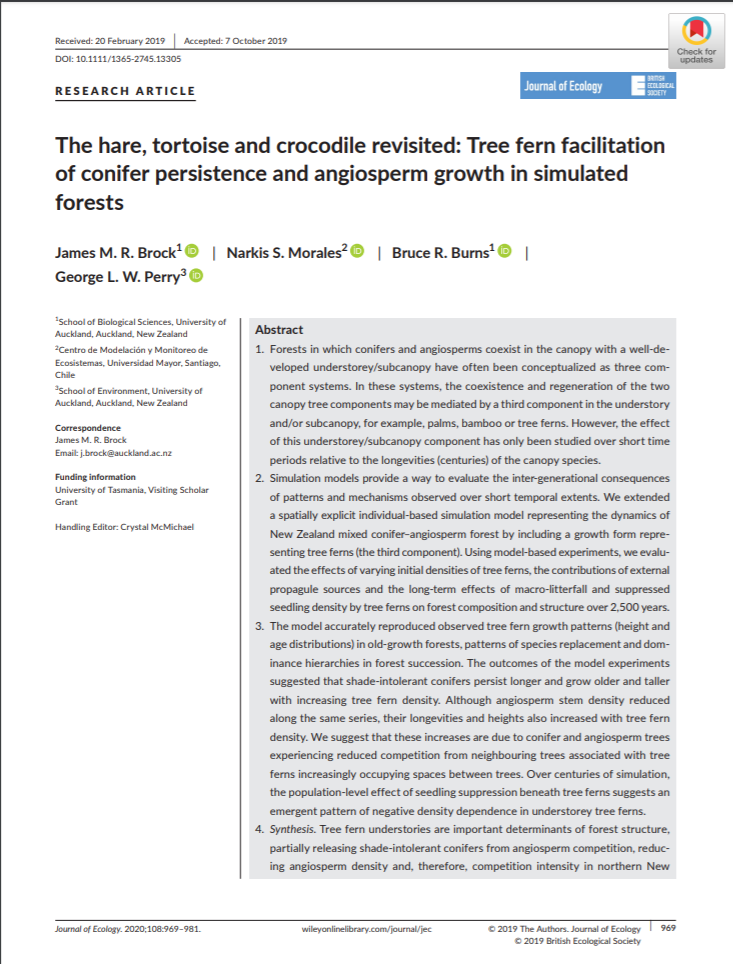The hare, tortoise and crocodile revisited: Tree fern facilitation of conifer persistence and angiosperm growth in simulated forests

Fecha
2019Autor
Morales, Narkis S. [Univ Mayor, Ctr Modelac & Monitoreo Ecosistemas, Santiago, Chile]
Brock, James M. R.
Burns, Bruce R.
Perry, George L. W.
Ubicación geográfica
Notas
HERRAMIENTAS
Acceda a títulos restringidos
¿Cómo descargar?Resumen
Forests in which conifers and angiosperms coexist in the canopy with a well-developed understorey/subcanopy have often been conceptualized as three component systems. In these systems, the coexistence and regeneration of the two canopy tree components may be mediated by a third component in the understory and/or subcanopy, for example, palms, bamboo or tree ferns. However, the effect of this understorey/subcanopy component has only been studied over short time periods relative to the longevities (centuries) of the canopy species. Simulation models provide a way to evaluate the inter-generational consequences of patterns and mechanisms observed over short temporal extents. We extended a spatially explicit individual-based simulation model representing the dynamics of New Zealand mixed conifer-angiosperm forest by including a growth form representing tree ferns (the third component). Using model-based experiments, we evaluated the effects of varying initial densities of tree ferns, the contributions of external propagule sources and the long-term effects of macro-litterfall and suppressed seedling density by tree ferns on forest composition and structure over 2,500 years. The model accurately reproduced observed tree fern growth patterns (height and age distributions) in old-growth forests, patterns of species replacement and dominance hierarchies in forest succession. The outcomes of the model experiments suggested that shade-intolerant conifers persist longer and grow older and taller with increasing tree fern density. Although angiosperm stem density reduced along the same series, their longevities and heights also increased with tree fern density. We suggest that these increases are due to conifer and angiosperm trees experiencing reduced competition from neighbouring trees associated with tree ferns increasingly occupying spaces between trees. Over centuries of simulation, the population-level effect of seedling suppression beneath tree ferns suggests an emergent pattern of negative density dependence in understorey tree ferns.Synthesis. Tree fern understories are important determinants of forest structure, partially releasing shade-intolerant conifers from angiosperm competition, reducing angiosperm density and, therefore, competition intensity in northern New Zealand forests. In many forest ecosystems, conifer-angiosperm forest dynamics can be conceptualized as three component systems. Foreign language abstractMaori He nui nga wa kua whakaarohia nga momo ngahere e noho tahi ana te rakau koro me te tipu whaipua ki te puhikaioreore me he ururua pakari he momo p<umacron>naha takitoru. I enei p<umacron>naha ko te nohonga tahitanga me te whakatipu reanga o nga waehanga rakau kahekoheko e rua ka whakaratarata i tetahi waehanga an i te ururua, ara ko nga huruwhenua, ko nga inanga, a, ko nga momo mamaku. Heoi an, ko te hua ka puta i taua waehanga ururua kaore an kia ata mataihia pera i ta te arotakenga o te oranga rautau o nga momo rakau o te kahekoheko. He ara an te tauira whakatakune ki te arotake i nga tukunga ihotanga a whakapapa nei o nga momo tauira, o nga tikanga i ata mataihia i nga whakatauine-wa popoto. I tukua kia roa ke tetahi whakatakune mokowa whakamarama t<umacron>haha kia whakatauirahia ai nga nukunuku o te ngahere rakau koro/tipu whaipua ma te tuku i te whakatipuranga o tetahi ahuatanga hei tauira o nga momo mamaku (te waehanga tuatoru). Ma te whakamatautau tauira e arotake ai nga panga o nga momo t<umacron> tata, nga momo t<umacron> tawhiti o nga mamaku, te toronga atu o nga puna whakamakuru me te panga o te takanga pararakau rangiwhawha, te pururua kakano kua tami i nga mamaku i te hangaanga, i te anga hoki o te ngahere i te roanga o nga tau e 2,500. I tika ra ta te tauira whakaputanga i te ahua o te whakatipu mamaku (nga ttaringa teitei me nga ttaringa pakeke) i nga ngahere o whakapata, i te whakakapinga, i te whakatuanuitanga o te raupapatanga o tenei nei ngahere. Ko ta te whakamatautau tauira, ko nga rakau koro hkaikai ana ki te marumaru ka ora roa ake, ka tipu pakeke ake, ka rea teitei ake me he katata tonu nei te tipu o te mamaku ki a ia an. Heoi an, i heke ke te noho katata o te tata tipu whaipua i tenei tauira tonu. Engari, ko te roa o ratou oranga, ko te teitei o a ratou tupu i piki ake i te nohonga katata tonutanga o aua mamaku. Ko ta matou, ko nga pikinga i kitea nei i nga rakau koro, me nga tipu whaipua ka puta mai i te mea kaore aua rakau e pakanga ki a ratou an i te whakakk whawharuatanga o nga mamaku i te wahi o waenga i nga rakau nei o te kahekoheko. I te whakatakunetanga e hia rautau nei te roa ko te hua kua puta i te tamitanga o te kakano i raro iho ra i te whakatupuranga matomato o te mamaku, ka kia ko te putanga ketanga mai o tenei ahua ko te noho katata-whakawhirinaki trarotanga o nga mamaku o te ururua. Whakakapinga. Ko te ururua mamaku he whakataunga whakahirahira i te anga o te ngahere, e tukuna ana te rakau koro hkaikai ana i te marumaru o te tipu whaipua, i whakawehewehe i te nohonga katatanga o te tipu whaipua, kia kaua e kaha tonu te pakanga i waenga i nga rakau o te kahekoheko i nga ngahere o te tokerau o Aotearoa. He nui nei nga p<umacron>naha rauropi ngahere ka kitea nga ahuatanga o te nehenehe rakau koro/tipu whaipua ka whakatinanahia hei p<umacron>naha waehanga takitoru.
Coleccion/es a la/s que pertenece:
Si usted es autor(a) de este documento y NO desea que su publicación tenga acceso público en este repositorio, por favor complete el formulario aquí.